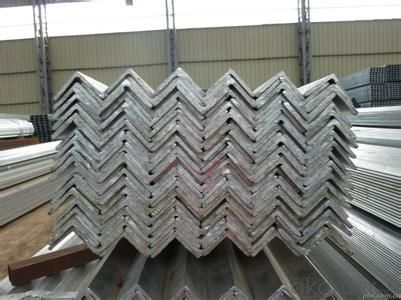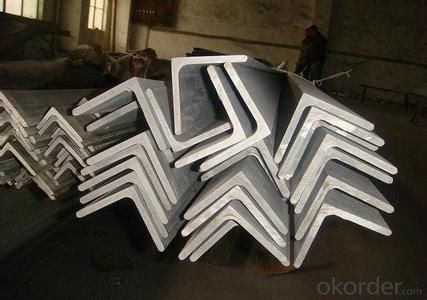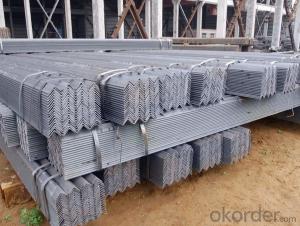Equal Angle Steel and Unequal Angle Steel Hot Rolled
- Loading Port:
- Tianjin
- Payment Terms:
- TT OR LC
- Min Order Qty:
- 25 m.t.
- Supply Capability:
- 20000000 m.t./month
OKorder Service Pledge
OKorder Financial Service
You Might Also Like
Product Description:
OKorder is offering high quality Hot Rolled Steel I-Beams at great prices with worldwide shipping. Our supplier is a world-class manufacturer of steel, with our products utilized the world over. OKorder annually supplies products to European, North American and Asian markets. We provide quotations within 24 hours of receiving an inquiry and guarantee competitive prices.
Product Applications:
According to the needs of different structures, Angle can compose to different force support component, and also can be the connections between components. It is widely used in various building structures and engineering structures such as roof beams, bridges, transmission towers, hoisting machinery and transport machinery, ships, industrial furnaces, reaction tower, container frame and warehouse etc
Product Advantages:
OKorder's Steel I-Beams are durable, strong, and resist corrosion.
Main Product Features:
· Premium quality
· Prompt delivery & seaworthy packing (30 days after receiving deposit)
· Corrosion resistance
· Can be recycled and reused
· Mill test certification
· Professional Service
· Competitive pricing
Product Specifications:
Manufacture: Hot rolled
Grade: Q195 – 235
Certificates: ISO, SGS, BV, CIQ
Length: 6m – 12m, as per customer request
Packaging: Export packing, nude packing, bundled
Sizes: 25mm-250mm | ||||||||||||
a*t | ||||||||||||
25*2.5-4.0 | 70*6.0-9.0 | 130*9.0-15 | ||||||||||
30*2.5-6.6 | 75*6.0-9.0 | 140*10-14 | ||||||||||
36*3.0-5.0 | 80*5.0-10 | 150*10-20 | ||||||||||
38*2.3-6.0 | 90*7.0-10 | 160*10-16 | ||||||||||
40*3.0-5.0 | 100*6.0-12 | 175*12-15 | ||||||||||
45*4.0-6.0 | 110*8.0-10 | 180*12-18 | ||||||||||
50*4.0-6.0 | 120*6.0-15 | 200*14-25 | ||||||||||
60*4.0-8.0 | 125*8.0-14 | 250*25 | ||||||||||
FAQ:
Q1: Why buy Materials & Equipment from OKorder.com?
A1: All products offered byOKorder.com are carefully selected from China's most reliable manufacturing enterprises. Through its ISO certifications, OKorder.com adheres to the highest standards and a commitment to supply chain safety and customer satisfaction.
Q2: How do we guarantee the quality of our products?
A2: We have established an advanced quality management system which conducts strict quality tests at every step, from raw materials to the final product. At the same time, we provide extensive follow-up service assurances as required.
Q3: How soon can we receive the product after purchase?
A3: Within three days of placing an order, we will begin production. The specific shipping date is dependent upon international and government factors, but is typically 7 to 10 workdays.


- Q:How do steel angles perform in corrosive or acidic environments?
- Steel angles exhibit strong performance in environments that are corrosive or acidic, but their effectiveness is contingent upon the type of steel employed and the specific conditions of the environment. For instance, stainless steel angles possess exceptional resistance to corrosion and can endure exposure to acidic environments without substantial deterioration. This is due to their high chromium content, which generates a protective layer on the surface upon contact with oxygen, thereby impeding further corrosion. Conversely, carbon steel angles demonstrate heightened vulnerability to corrosion in corrosive or acidic environments. They lack the same degree of chromium content and protective layer, rendering them more susceptible to rusting and degradation when confronted with such circumstances. Consequently, in these scenarios, supplementary protective coatings or treatments, such as galvanization or painting, may be necessary to augment their corrosion resistance. Moreover, the severity and concentration of corrosive or acidic substances within the environment can also influence the performance of steel angles. Elevated concentrations of acids or corrosive substances can expedite the corrosion process, even for stainless steel angles. Consequently, it is essential to meticulously evaluate the specific environment and select the appropriate steel material and protective measures accordingly to ensure optimal performance and longevity in corrosive or acidic environments.
- Q:How do you determine the load capacity of a steel angle?
- The load capacity of a steel angle is determined by calculating its moment of inertia and considering factors such as material strength, dimensions, and the type of loading it will be subjected to. Additionally, engineering standards and codes provide guidelines for determining load capacities based on these calculations.
- Q:What are the different types of steel angles used in construction?
- There are several different types of steel angles commonly used in construction. These angles are formed by bending a piece of steel into a 90-degree angle, creating an L-shape. The different types of steel angles used in construction include: 1. Equal angles: These angles have equal lengths on both sides, forming a right angle. They are commonly used for making frames, supports, or braces in construction projects. 2. Unequal angles: As the name suggests, unequal angles have different lengths on each side. They are often used in applications where one side needs to be longer or shorter than the other. Unequal angles are commonly used for structural support in buildings, bridges, and other infrastructure projects. 3. L-shaped angles: These angles have a 90-degree bend but do not have equal lengths on both sides. They are often used in situations where a specific length is required on one side, such as creating a shelf or bracket. 4. Rolled steel angles: These angles are produced by passing a steel strip through a series of rollers, which shape it into the desired angle. Rolled steel angles are commonly used in construction projects for their strength and durability. 5. Stainless steel angles: Stainless steel angles are made from a corrosion-resistant alloy, making them ideal for applications where they may be exposed to moisture or harsh environments. They are commonly used in construction projects where aesthetics and longevity are important, such as architectural structures or exterior cladding. 6. Galvanized steel angles: Galvanized steel angles are coated with a layer of zinc to protect them from corrosion. This makes them suitable for outdoor applications, where they may be exposed to moisture or harsh weather conditions. Galvanized steel angles are commonly used in construction projects, such as fences, handrails, or outdoor structures. In summary, the different types of steel angles used in construction include equal angles, unequal angles, L-shaped angles, rolled steel angles, stainless steel angles, and galvanized steel angles. Each type has its own unique properties and applications, making them versatile and essential components in various construction projects.
- Q:What is the fire resistance rating of steel angles?
- The fire resistance of steel angles relies on several factors, including the angle's size and thickness, the type of steel employed, and the specific fire protection measures implemented. Steel possesses inherent fire resistance due to its high melting point and low thermal conductivity. Nevertheless, the fire resistance can be improved by applying fireproofing materials, such as intumescent coatings or fire-resistant boards, to the steel angles. By providing insulation and slowing down heat transfer to the steel, these fire protection measures can significantly augment the fire resistance of steel angles. The specific fire resistance rating may differ depending on the thickness and type of fireproofing materials employed. For instance, a steel angle coated with a particular fireproofing substance may have a fire resistance rating of 60 minutes, signifying its ability to withstand fire exposure for up to 60 minutes without compromising its structural integrity. To determine the specific fire resistance requirements for steel angles in a specific application, it is crucial to refer to local building codes, regulations, and fire safety standards. These standards can offer guidance on the necessary fire protection measures and the minimum fire resistance ratings that must be met in different construction scenarios.
- Q:Can steel angles be used for shelving and storage racks?
- Yes, steel angles can be used for shelving and storage racks. Steel angles are commonly used in construction and engineering due to their strength and durability. They provide excellent structural support and can withstand heavy loads, making them ideal for shelving and storage racks. Steel angles can be easily fabricated and welded together to create the desired shelving or storage rack design. They are also available in a variety of sizes and thicknesses, allowing for customization to fit specific storage needs. Additionally, steel angles are resistant to corrosion, which is beneficial in environments where moisture or chemicals may be present. Overall, steel angles are a reliable and versatile choice for shelving and storage racks.
- Q:Are steel angles fire resistant?
- Yes, steel angles are fire resistant. Steel is a non-combustible material, and when properly designed and installed, steel angles can withstand high temperatures and maintain their structural integrity during a fire.
- Q:What are the different types of corrosion that can affect steel angles?
- There are several types of corrosion that can affect steel angles, including: 1. Uniform corrosion: This is the most common type of corrosion and occurs when the entire surface of the steel angle corrodes evenly. It is typically caused by exposure to moisture and oxygen in the environment. 2. Pitting corrosion: Pitting corrosion is characterized by the formation of small pits or holes on the surface of the steel angle. It occurs when localized areas of the metal are exposed to more aggressive corrosive agents, such as chloride ions or acidic substances. 3. Galvanic corrosion: Galvanic corrosion happens when two different metals are in contact with each other in the presence of an electrolyte, such as water or saltwater. The more active metal (the anode) corrodes while the less active metal (the cathode) remains protected. 4. Crevice corrosion: Crevice corrosion occurs in confined spaces or crevices where stagnant water or moisture can accumulate. The lack of oxygen and the concentration of corrosive agents can lead to localized corrosion and degradation of the steel angle. 5. Filiform corrosion: This type of corrosion appears as thread-like filaments that form on the surface of the steel angle. It is typically caused by the presence of moisture and oxygen, as well as the presence of contaminants such as salts or organic compounds. 6. Stress corrosion cracking: Stress corrosion cracking occurs when a combination of tensile stress and a corrosive environment causes cracks to form in the steel angle. It can be particularly dangerous as it can lead to sudden and catastrophic failure of the structure. It is important to note that the severity and likelihood of each type of corrosion can vary depending on factors such as the environment, exposure to corrosive agents, and the quality of the steel angle itself. Regular inspection, maintenance, and appropriate protective coatings can help mitigate the effects of corrosion on steel angles.
- Q:How do steel angles perform in terms of thermal expansion and contraction?
- Compared to other materials, steel angles exhibit a relatively low coefficient of thermal expansion. This characteristic allows them to expand and contract less when exposed to changes in temperature. As a result, steel angles demonstrate exceptional stability in terms of thermal expansion and contraction. Consequently, they find extensive usage across diverse structural applications that anticipate temperature variations. The utilization of steel angles ensures structural integrity and stability, even in environments characterized by significant temperature fluctuations, thereby establishing their reliability for construction and engineering projects.
- Q:What is angle flower? Is it the same as angle iron?
- Welded steel pipe, welded pipe, welded steel pipe, is the same meaning, also called welded steel pipe, seamless steel tube is compared with the. Seamed tube is made of steel plates or strips welded together. Because of the different manufacturing process, it can be divided into longitudinal welded pipe and spiral welded pipe.
- Q:Can steel angles be used for architectural detailing?
- Indeed, architectural detailing can make use of steel angles. These versatile structural elements find application in diverse architectural scenarios. They serve to provide stability and support to structures, fulfilling framing, bracing, and reinforcing purposes. Examples of steel angle implementation can be observed in architectural features like window frames, door frames, staircases, and handrails, among others. Their inherent strength and durability render them fitting for both interior and exterior architectural designs. Furthermore, steel angles can be effortlessly tailored and manufactured to meet precise design specifications, empowering architects to conceive distinctive and visually appealing architectural details.
1. Manufacturer Overview |
|
|---|---|
| Location | |
| Year Established | |
| Annual Output Value | |
| Main Markets | |
| Company Certifications | |
2. Manufacturer Certificates |
|
|---|---|
| a) Certification Name | |
| Range | |
| Reference | |
| Validity Period | |
3. Manufacturer Capability |
|
|---|---|
| a)Trade Capacity | |
| Nearest Port | |
| Export Percentage | |
| No.of Employees in Trade Department | |
| Language Spoken: | |
| b)Factory Information | |
| Factory Size: | |
| No. of Production Lines | |
| Contract Manufacturing | |
| Product Price Range | |
Send your message to us
Equal Angle Steel and Unequal Angle Steel Hot Rolled
- Loading Port:
- Tianjin
- Payment Terms:
- TT OR LC
- Min Order Qty:
- 25 m.t.
- Supply Capability:
- 20000000 m.t./month
OKorder Service Pledge
OKorder Financial Service
Similar products
New products
Hot products
Related keywords




























